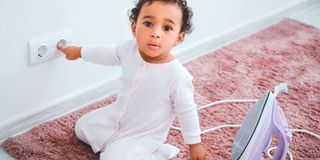Child safety: Your guide to childproofing your home

Always unplug and store away your iron box immediately you are done ironing.
What you need to know:
- Do not place your television on a stand or table, have it mounted to a wall with a steady wall bracket.
- Have all your furniture covered with cushioned strips or padded guards.
- If your home has a staircase, make sure it is covered with a non-slippery carpet or stairs.
The home is a safe haven for the family. However, the home is not always immune to accidents. Every now and then, fatal accidents are reported in homes. Many of these accidents can be prevented by childproofing the home. Here is a guide on what you need to do to childproof your home.
Household chemicals: These include bleach, paraffin, and other toxic products. Ensure they are stored in places where kids cannot see or reach them. Store them in locked cabinets or shelves. Store all medicine in their original containers and away from food products. “Do not store paraffin in regular bottles that are associated with soft drinks such as soda bottles. Your child could mistake them for something edible,” says interior designer Carole Andeka.
Electric shocks and gadgets: Have all sockets covered with safety caps. The alternative is to place heavy furniture that children can’t move in front of the sockets. This will prevent your kids from sticking objects or fingers into the sockets. Make a habit of charging your phones away from your children. Unplug your charger immediately your phone is fully charged, and cover the socket with a safety cap. This will stop your child from putting the charger in their mouth in the event they access it. “At the same time, always unplug and store away your iron box immediately you are done ironing to prevent your child from burning,” she says.
The bathroom: Have a doorknob cover and a door lock installed on your bathroom door. Ensure the knob cover is sturdy and allows a door to be opened quickly by an adult in case of emergency. Since most bathrooms are built with standard tiles, consider redoing the floor and installing non-slip tiles to minimise the risk of falls. On your toilet, install safety locks to keep the lid closed when not in use. This will ensure your child will not access the bowl in the event they find their way to the bathroom. If you have a bathtub, ensure water inlets are not easily accessible to the child and cannot be turned on easily. “If your bathroom has a hot-water system, ensure the temperature of the water released from the showerhead is not too hot to cause scalding of children,” says Andeka. She recommends you have your plumber and electrician install a device that can turn off the water at a predetermined temperature of about 48 degrees Celsius.
The television: Do not place your television on a stand or table. Instead, have it mounted to a wall with a steady wall bracket. The wall must be placed at a place where your child cannot easily reach it or its accompanying electrical accessories.
Furniture: It is possible for crawling babies to injure themselves by knocking their heads on sharp furniture such as tables. To avoid this, have all your furniture covered with cushioned strips or padded guards. When purchasing new tables and furniture, select those with round edges instead of those with angular edges.
Plants: If you want to decorate your home with plants, consult an interior designer who can have your plant pots and vases suspended on the wall or attached to the wall steadily to avoid breakage and toppling. Also, ensure whatever plants you go for are not poisonous.
The staircase: If your home has a staircase, make sure it is covered with a non-slippery carpet or stairs. The alternative can be a wooden staircase that will not be slippery and prone to tumbling. You should also install a small child gate at the top and bottom of the staircase. This will prevent the child from accessing the staircase unsupervised. The child gate should be installed when the baby is around six months or just before they start crawling. “For the top of stairs, only use gates that screw to the wall. Use safety gates that meet current safety standards,” says Andeka. “At the bottom, you can use a gate that is not screwed to the wall. This gate is also known as a pressure-mounted gate.” Ensure the pressure bar for this gate is located on the inside to prevent the child from using it as a toehold to climb on.
Smoke alarms: Install smoke alarms in your home, including inside every bedroom, and outside sleeping areas such as the living room. “This will alert you in advance in the event of a possible fire outbreak. Check your smoke alarms once a month to make sure they are still working,” says Andeka. Also install a Carbon Monoxide (CO) alarm to help you detect and prevent CO poisoning, especially in sleeping areas. For the two types of alarms, Andeka recommends you change batteries at least once a year or use long-life batteries such as the ten-year warranty batteries.





